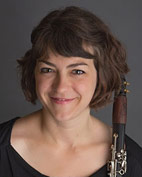5 Minute Interview: Rachel Yoder, Editor of The Clarinet
What is your current position?
I currently serve as editor of The Clarinet, quarterly journal of the International Clarinet Association. I also am an adjunct professor of music theory and clarinet at the DigiPen Institute of Technology, where we have an undergraduate program for video game composers and sound designers.
Who have been your biggest influences in clarinet?
My biggest influences have been my teachers, including James Gillespie, Caroline Hartig, Elsa Ludewig-Verdehr and my high school teacher Claudia Mickelson. Today, I am endlessly inspired by the contributors to The Clarinet. As editor, I have the honor of corresponding with clarinetists all around the world and working to bring their expertise and research to our readers. In the process, I learn an incredible amount about our instrument that influences me as a performer and teacher.
How long have you been a member of the ICA?
Since about 2004.
How long have you played the clarinet?
Since fifth grade, when I was 9.
What do you love the most about the clarinet?
I love the range of the instrument, the timbre and its versatility.
What is your current setup?
I play on Buffet R-13s with a Behn Zinner blank mouthpiece, Muncy Winds barrel and my beloved Scottie ligature with D’Addario Evolution reeds. For bass I play a Selmer with a Fobes mouthpiece and D’Addario Reserve Classic Reeds. I play a Buffet E-flat with a magical Fobes mouthpiece and D’Addario reeds.
Why do you think every clarinetist should be a member of the ICA?
The best reason to join is to expand your clarinet horizons! Becoming a member allows you to learn more about the instrument’s history, current music, performers and much more through our quarterly journal The Clarinet, and attending our annual ClarinetFest® is an incredible experience for any clarinetist. Participating in the ICA will make you a better performer and/or teacher by connecting with the global clarinet community.
What is your favorite piece for clarinet?
It’s so hard to pick just one… of course I love Mozart and Brahms, but I’m fascinated by how several 20th-century composers managed to encapsulate diverse aspects of the clarinet’s character: Gershwin (jaunty jazz), Messiaen (haunting, ethereal beauty), William O. Smith (multiphonic and microtonal possibilities), Reich (driving, lyrical minimalism).
What do you find the most challenging about the clarinet?
Right now, with two small kids, my biggest challenge is finding time to practice! In general, I find entrances the most challenging aspect of performing on clarinet, especially in large ensembles – just having that beautiful, supported sound at the correct dynamic ready to blossom, right on cue. Many aspects of playing the clarinet have become automatic after playing the clarinet for so long, but entrances are something I always have to work at, especially on bass.
What are your tips for clarinetists?
Work on your fundamentals. Make progress as quickly as possible and extract every bit of knowledge you can out of your teachers: practice diligently, take notes, and attend as many performances and clarinet events as possible. Once you’ve gained a certain level of competency on the instrument, my next recommendation is to find your passion. What excites you about the instrument? Is it a certain type of repertoire? Instrument repair? Creating a chamber ensemble? Pedagogy? Marketing? Find your passion – or ideally, passions – and run with it. Today, there are many talented clarinetists throughout the world, and you will only be successful if you pursue your specific interests with passion and enthusiasm, and lots of hard work. This will set you apart from others and lead to opportunities to do something we don’t talk about enough in music schools: make money. It’s not the reason we do what we do, but it’s what makes the musician lifestyle possible!
What is a clarinet recording that you recommend?
I can’t stop thinking about a set of recordings I heard recently by Nora-Louise Müller using the Bohlen-Pierce clarinet, a custom clarinet created to play in the Bohlen-Pierce scale which consists of the interval of a twelfth divided equally into 13 steps. Rather than sounding like a microtonal variant of the traditional chromatic system, it sounds very resonant and beautiful but in a completely fresh way. I believe this recording is a work in progress and will be released soon. Look for an article on this instrument in an upcoming issue of The Clarinet!
You can hear what this unique instrument sounds like in the YouTube video below.

Comments are closed.